This post recounts the moments following the dismasting disaster about the dismasting of our Bluewater sailboat, a Valiant 40, ‘Brick House’, in 2011, while sailing in the remote atolls of Kiribati, enroute to Vanuatu in the South Pacific
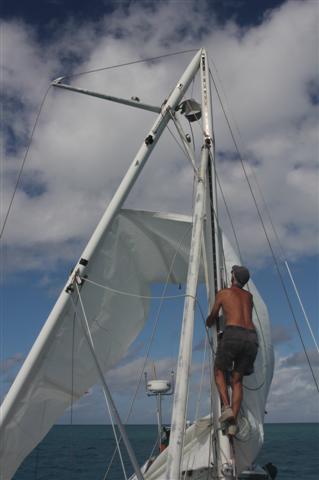
DISMASTED
Again my head slammed into the bent and mangled mast. What had appeared a rolly anchorage amongst coral reefs was a Twirl-A-Ride at the top of our broken mast stump. The other mast half was folded over the side of the boat, dipping in the water.
Tethered 20 feet above the deck the words of Bill Seifert in his book Offshore Sailing were being bounced out of my memory. “Cotter pins should not be bent open more than 10 degrees.” Cotter pins which were bent open at a small angle, holding dangling rigging, were easy to slip free from the clevis. The pins bent into a curlicue were taking all my effort, strength and patience to bend straight with pliers and small screwdrivers. They were becoming a real headache, in every form.
The day before, when sailing south in sunshine and gentle breeze, the squall had come on us suddenly. Rebecca, and I were below as the wind slammed. But it was only 30 knots; wind this boat can easily handle although I would have preferred to shorten sail. As I moved to the wheel to turn downwind to ease the pressure, I heard a pop and watched the top of the mast along with reefed mainsail and genoa, fold gracefully to starboard; the mast creasing just below the spreaders. Situations I had read and heard about in wild weather in terrible latitudes were now upon my wife and me. The big difference was that we were dressed in shorts and T-shirts 95 miles south of the equator and 307 miles west of the International Date Line, near the southern stretch of the Kirabati atolls.
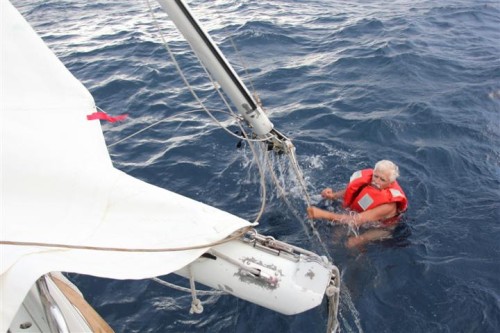
Then the mast section sticking up from the deck jerked sharply to starboard as though it could be twisted out of shape. That marked the starting point. We had already turned downwind to ease the rolling but the jib furler and genoa dragging in the water were still attached to the top of the mast which was also scraping the ocean with each roll of the boat. The sail, having opened like a baleen’s mouth, transferred tremendous pressure, torquing what remained of the unsupported rig. It became obvious that the immediate job was to dive into the ocean and cut the genoa halyard free of the dragging and plunging mast tip and pull the toggle pin to free the head stay and genoa furler. But the boat could leave me behind creating an additional unpleasant situation. We looked over the sides and pulled what wet sails and lines we could find inside of the lifelines before starting the engine. Shifting into reverse at idle, the tortured genoa wallowed and collapsed its load of ocean and sat there undulating like a large Dacron jellyfish.Although Brick House was no longer moving, I wore a life jacket and rope tether for my initial time in the ocean. If I were injured or the boat began to move again, this would give Rebecca a lifeline to me. Later, swim fins without a lifejacket gave me the mobility needed to complete the work.With the ocean and mast moving in syncopated directions, the work was dangerous and difficult, limiting me to intermittent attempts at freeing the sail hanging from the upside-down mast. The biggest threat was being punched in the head or shoulders by the mast slamming then pulling back from the ocean. I was watchful, but with one plunge I was unable to move quick enough. In nanoseconds, I had the frightening feeling of terrible injury as growing pressure seemed intent to pierce my thigh; but the offending VHF antenna bent like a child’s sword leaving me only with a feeling of good luck. As soon as the genoa was freed from the mast, Rebecca stopped the engine and together we hauled the sail and furling gear on board.
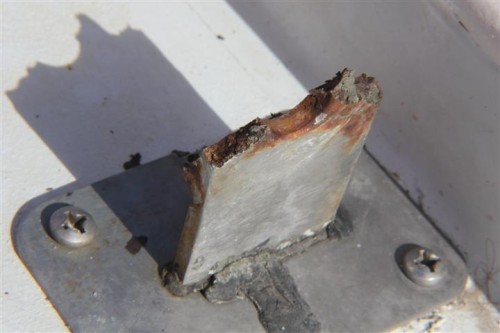
It was the failure of the port upper shroud chainplate that caused the mast to fold. In the fall, the upper shroud wrapped over the top of the stump pulling with it, 4 feet into the air, a 5 gallon jug of outboard gasoline. The gas spilled a slippery, smelly slick on the port side deck which added to our difficulties. The other shrouds lay in a mass of stiff spaghetti snaking around the deck.
We did not want to pull pins or cut cables and heave equipment overboard. We needed to save and rebuild everything we could. Besides, with a keel stepped mast, there is no way to jettison a bent and toppled mast without first cutting it through at deck level.
It took hours to regain order and secure supports to the dragging mast head. We hardly noticed the sun disappearing till we could see no more. But now we could not risk starting the engine for a second time without first entering the dark ocean and verify fully nothing would tangle in the propeller.
Our underwater light was invaluable this evening. Normally I plunge the reefs in daylight looking for sizable fish to pursue. Tonight I entered the black ocean slowly, the narrow beam of light searching for the profile and glinting eyes of large pursuers. But in the glow, the keel of Brick House and I were the only things swimming. Everything below the waterline looked tranquil except for the boarding ladder which rolled and bubbled deep in white foam then rose again. We could start the engine and be on our way. Click,click,click. How could this be? The only time in four years, when I most need the engine to start, and it won’t turn over even though the battery is fully charged! Click, click, click. Unbelievable. I am always in the engine room checking, cleaning, changing. Click, click. I had visions of now jury rig sailing southwest, 960 miles to Vanuatu. Rebecca put the battery selector to “Both”. The engine dragged slowly then revved and purred. At no time after this did the engine ever falter to start!
The north end of Tabiteuea is not an atoll but a long, low coconut island open to the west. It was the least bumpy anchorage we could reach in our situation. We had all night to pass the 25 miles to get there. Only when the sun was high did we slowly wind through the uncharted labyrinth of coral till our way was fully blocked, two miles from shore.
In the light of a new day, Rebecca was incredibly despondent looking at our broken home. I reminded her about the quote; “The difference between adversity and adventure is attitude.” I asked, “Isn’t this an adventure?!” Her eyes reddened and watered, “We are ruined…this is nothing but a disaster!!!” In reality our situation could have been worse. At least we had our rudder and plenty of diesel fuel. But she pointed out, “If we had only known to change the chain plate we would be on our way to Vanuatu or Rotuma.”
In my diligence to shine our stainless steel, I had been polishing away the evidence. At the top of the chainplate, a second layer of steel had been welded to add thickness for the clevis pin to pull against. Moisture had been seeping between the two metals at the clevis pin hole. That chainplate was going to break and with luck it failed where an anchorage was not far away. I should have inspected the chainplates with a magnifying glass and crack exposing dye or, better yet, replaced them on a scheduled basis like we do the wire stays.
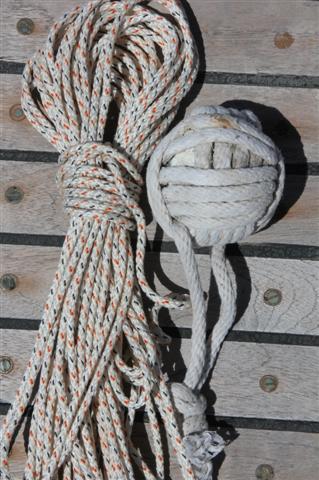
In our bumpy anchorage the first task was to save the main sail. When the mast folded, the main sail slides did the splits; one group stayed on the vertical mast stump and the remaining were stuck in the fallen section. The stress stopped at a point which allowed the sail to spread but not enough to tear it apart. The first order was to reach the uppermost slide on the stump and cut the tabbing or pull the pin on the slide to relieve the pressure. Using the halyard brakes for steps, just enough of a toe hold allowed the proper reach. With that release of pressure the remaining slides on one side of the sail slid off the bent mast into the ocean. The other slides were released from the mast at the gooseneck. The mainsail was then flaked onto the boom and covered with the sail cover.
The next problem was to figure out how to get to the top of the stump. From there I could then release more dangling wires, secure rope stays all around and set blocks for halyards. Lacking the native skills to climb coconut palms, we decided to first get a messenger line over the mast to which a stronger line would follow.
The one firearm we have on board is a high powered slingshot. It seemed reasonably simple to shoot a projectile with kite string attached over the mast. The problem was, no matter how carefully the string was flaked in preparation for the shot, the run would snag on the slightest resistance and pull itself into a tangle. Far more time was spent untangling cats cradles than slinging out the projectile. We pulled out the heavy artillery. The monkey’s fist is a hardball of zinc artfully wrapped in rope and tied to 3/16″ line. Although cushioned by the wounds of line, the fist can smash solar panels and split deck hatches. As I was gearing up for my aerial bombardment, Rebecca scrambled to spread a bed of cushions.
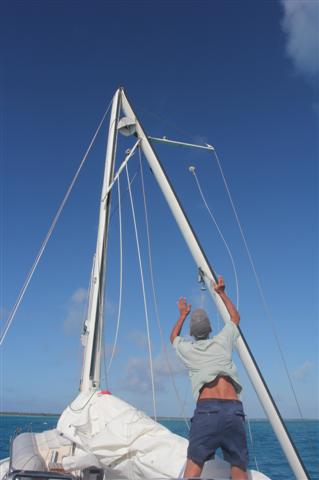
Throw after throw of the monkey’s fist went high, low, and into left field. Several times the fist draped over a hard spot and doubled back to wind around its trailing line like a tether ball. With great fortune, like a tether ball, it always unwound itself rather than spinning into a knot high out of reach.
I always had a better chance tossing a wringer with my eyes closed. After 18 throws, my tosses became less calculating and more menacing as my eyes squinted tighter. But then, as persistence and luck would have it, the fist sailed in a perfect arch gracefully laying its trailing line over the mast top at just the right angle. This messenger line pulled the 7/16″ diameter line over the mast and was secured to a cleat. To that line was attached the Top Climber.
The Top Climber is similar to what rock climbers or giant Sequoia tree ascenders use. The method is to stand in the foot straps then slide the hand gripper up the line to bring up the seat straps. Sitting in the seat straps, the foot straps are then slid up the line. It is progress which enables the user to easily identify with the mechanics of an inchworm. The system may be slow but it works for unassisted elevating. In a rolly anchorage, a helmet would be useful to ease the battering.
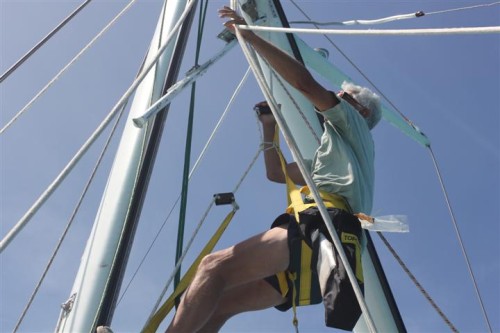
If the Top Climber system had not worked, there are two other ways to get to the top of the mast. The same 7/16″ line could pull up a block and tackle to which a bosuns chair is attached. A person in the chair can hoist himself and secure the line to the chair at the proper elevation. Any 50ish man who has used this system says it will tend to cramp the hands and certainly is not as easy to use as it once was. However, a person on deck could assist with the pulling and then secure the line to a deck cleat. The last option is to use the natives of the Pacific as inspiration and simply shinny the mast as it were a coconut palm while wearing a harness. At the top, the tether attached to the harness would be wrapped over the top of the mast and quickly made fast. Hanging there, the lines and pulley necessary for a bosuns chair could be secured before making a decent. This latter method is made even more difficult as hanging in mid air, ones own body weight gradually crushes deeper against the harness straps making movement and breathing difficult. Safe working time is short. While I was aloft on the Top Climber, Rebecca did what she could to steady lines to keep me from swinging and banging so hard against the rigging.
With access to the mast top, I was able only then to see a single bolt head from the running pole slide was all that the rope was truly resting on. A slip off that finger hold and I would have to grab something quickly as my support line would slide down the broken stay, over the spreader and into the ocean. There was little alternative but to stay focused and keep working while keeping constant pressure on the support line. I continued to drop all unnecessary wire stays and salvable electrical fitting from the mast to Rebecca’s waiting hands below. Spare lines from the cockpit locker were wrapped, woven and tied around the stump top to form head stays and back stays and shrouds. From three separate looped lines, 3 blocks were shackled and halyard lines rove. My work aloft, for this rocking anchorage anyway, was complete and I inched my way down with a headache and a several red scrapes and dings.
The first item to be raised on a halyard was the emergency Single Side Band antenna. Ours is a 1/8″ stainless steel wire, insulated on each end with plastic thimbles and tied with lines to the stern and bow pulpit. Plastic water hose was slid to the middle so when raised, the wire would be insulated from contact with the mast. The minimum length for an emergency antenna is 23 feet, the longer the better. Originally intended to go up a masthead halyard, our antenna is 46′ long. GTO-15 wire is the most prescribed wire for connecting the antenna to the antenna tuner but in our case the largest core wire we had on the boat was used. Our emergency antenna worked equally, if not better than the antenna which came down with the rigging. Over the weeks ahead, we would keep in touch with cruisers nets and to begin organizing the repairs of our boat.
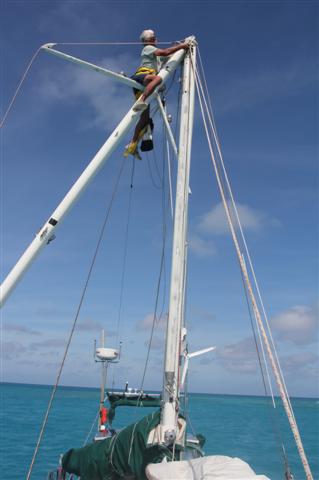
Mast dragging
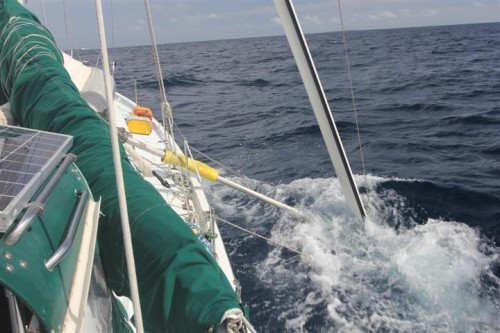
An off the wind radius had us looking for possibilities in Vanuautu and as far away as Australia and points north. What we needed most was fast mail and frequent cargo shipping from the U.S., a place to lay out a mast and a crane to lift it. 620 miles northwest lay Majuro, Marshall Islands. That U.S. associated island fit our repair requirements. But the seasonal winds were shifting to north of east which could make it a difficult, if not impossible target. We were racing the seasons with a slow, broken boat. Our first stop would be Tarawa, 225 miles to the northwest.
It must have been that seasonal shift which, for the only time in months, brought settled winds of less than 12 knots and at times a push from abaft the beam. Our odd looking sails assisted the diesel engine gliding us along at the most fuel efficient 1800 RPMs. Two days later we dropped the anchor in Tarawa off the town of Betio.
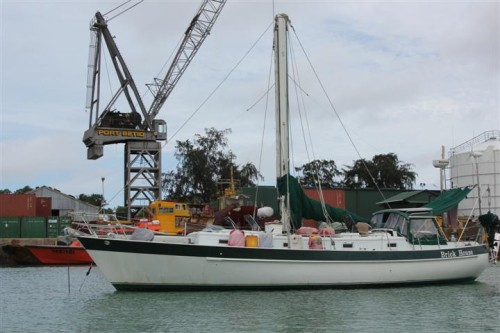
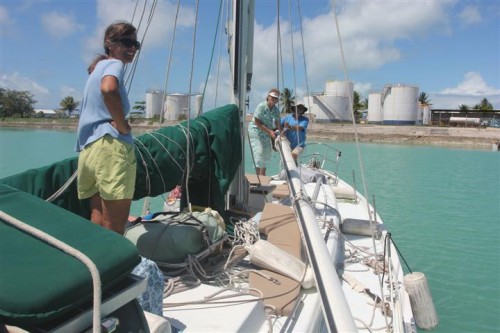
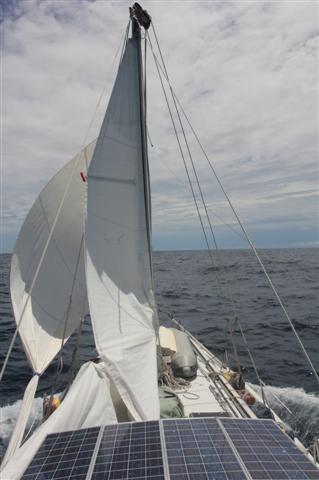
With a stubby rig that looked like something Shackleton would use to escape his Antarctic adventure, we worked our way north. As we sailed past other atolls we kept to their sheltered west shores and made comfortable progress in unseasonably tranquil conditions. Our bucket of luck was heavily tapped on this 390 mile passage. The customary 18 knot winds and large waves returned only as we picked up a mooring in the safety of Majuro.
At our destination, the tedious work of ordering materials and the wait for them to arrive would begin. Brick House had been cracked but soon it will sail with titanium chainplates and a rig to take us safely to whatever latitude we choose.
Are we insured? Find out How we choose to Insure this old boat!
A Tour of our Valiant 40. The Bluewater Sailboat. What do we like about it? What would we change?
As an Amazon Associate I earn from qualifying purchases



As a very old crousing sailor I jut admire your adventure,,,, old sailor 5 Bermuda races Ten SORC series one transatlantic b just admire you two Joe
Thanks Joe…appreciate that! Hope you have seen our YouTube channel too 😉
Wow what an amazing story of success in the face of a horrible event. Patrick and Rebecca you both are awesome. Very inspiring – don’s panic, don’t give up, work with what you got and make a plan to get somewhere safe and fix the boat!
Thanks David…appreciate your compliments! We did what we had to do..there was no alternative. But you have one part wrong…I panicked. Well…I cried, and didn’t know what to do….and was depressed etc. So I didn’t panic, but I did not handle it very well ;);Patrick, as usual was the true hero.